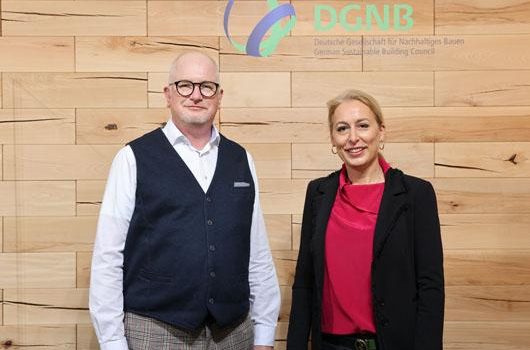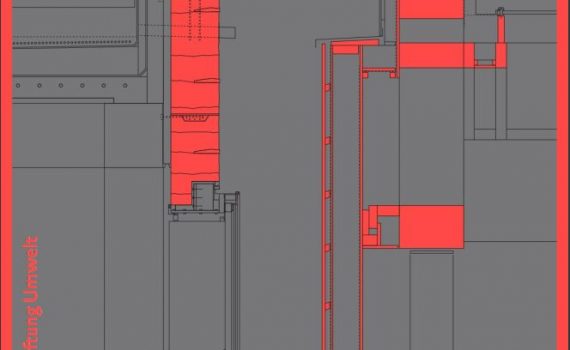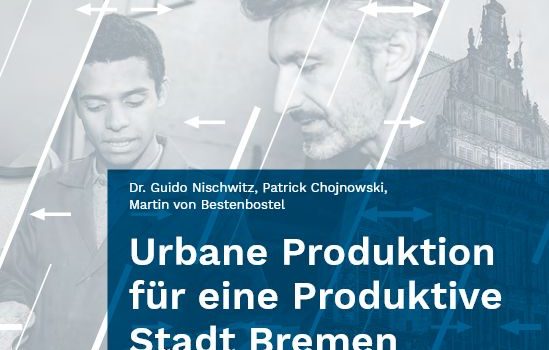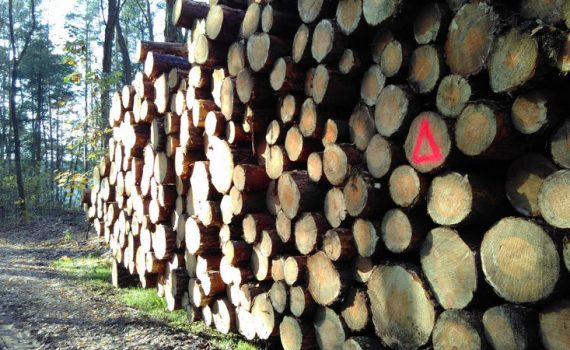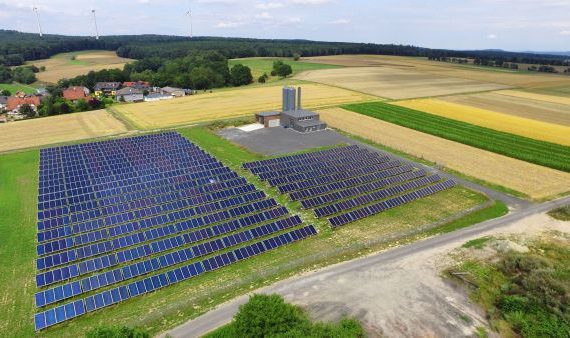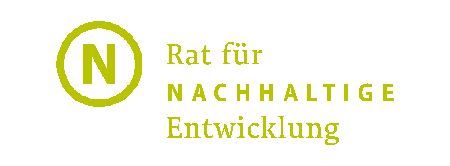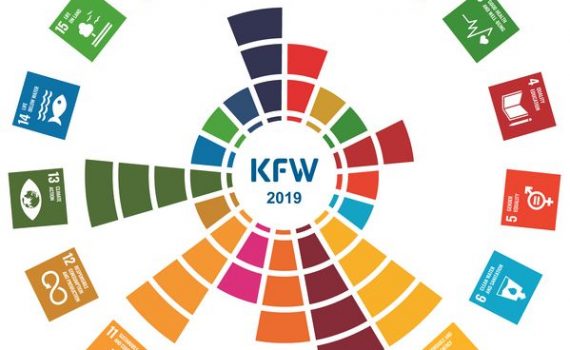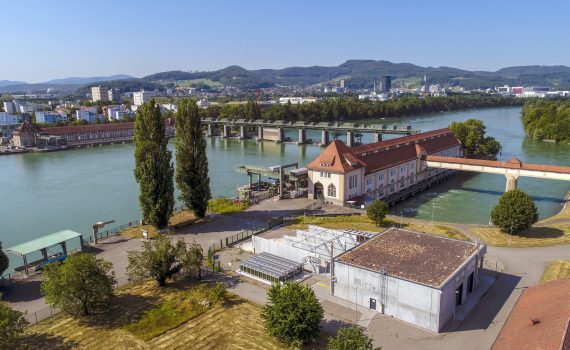Kategorie für Blog: Sustainable management
The Federal Cabinet today approved the draft of a timber construction initiative presented by Federal Minister of Construction Klara Geywitz and Federal Minister of Agriculture Cem Özdemir. This strategy of the Federal Government is intended to strengthen the use of wood as a sustainable raw material in the construction sector and to ensure more climate protection, resource efficiency and faster construction. With eight fields of action, from the exemplary role of the federal government and the strengthening of research and innovation, to securing skilled labour and knowledge transfer, to securing the supply of raw materials, the use of wood is to be significantly improved and the timber construction quota increased by 2030.
Scientific scenarios on climate neutrality support corporate strategy and planning on the path to decarbonisation - Using the example of buildings and heating, climate economists at DIW Berlin analyse existing scenarios on climate neutrality - Net zero scenarios show a clear path for the transformation of companies and the financial sector - With standardised scenarios and transition plans for climate neutrality, banks, funds and insurance companies can make their portfolios fit for the future.
The bioeconomy can be a central building block for the transformation of our largely coal, oil and gas-based economy. However, renewable raw materials and synthetic carbon compounds are scarce and expensive. They should be used in areas such as the chemical industry - not as energy sources. For the shift from a fossil-based economy to a bioeconomy to succeed, fossil carbon must also become more expensive. The ifeu now presents the results of four trend-setting studies.
Thüga closed the 2021 financial year with a good result. The approximately 100 municipal utilities and regional suppliers of the Thüga Group fully fulfilled their supply mandate and continued to drive forward the energy turnaround despite burdensome general conditions.
 "nWert", GLS Gemeinschaftsbank eG's sustainability rating tool for real estate, has been recognised by the German Sustainable Building Council (DGNB) as a sustainability rating. At the same time, GLS Bank recognises the DGNB certificate as proof when granting financing. This was announced by Dr. Christine Lemaitre of the DGNB and Dr. Matthias Morgenstern, GLS ImmoWert, on the occasion of Expo Real 2021 in Munich.
"nWert", GLS Gemeinschaftsbank eG's sustainability rating tool for real estate, has been recognised by the German Sustainable Building Council (DGNB) as a sustainability rating. At the same time, GLS Bank recognises the DGNB certificate as proof when granting financing. This was announced by Dr. Christine Lemaitre of the DGNB and Dr. Matthias Morgenstern, GLS ImmoWert, on the occasion of Expo Real 2021 in Munich.
 Author of the book review: Roman Schaurhofer, Vienna
The construction volume "Commercial Buildings in Clay and Wood - Added Value through Material" was published in 2020 by Sabine Djahanschah of the Deutsche Bundesstiftung Umwelt (German Federal Foundation for the Environment) at Verlag Detail. The publication, which appeared in book form, deals with the use of the building materials wood and clay in the construction of commercially used buildings. To this end, six buildings with commercial use were analysed in terms of their architectural construction and technical quality features and evaluated with the help of measurements, surveys and life cycle assessments.
Author of the book review: Roman Schaurhofer, Vienna
The construction volume "Commercial Buildings in Clay and Wood - Added Value through Material" was published in 2020 by Sabine Djahanschah of the Deutsche Bundesstiftung Umwelt (German Federal Foundation for the Environment) at Verlag Detail. The publication, which appeared in book form, deals with the use of the building materials wood and clay in the construction of commercially used buildings. To this end, six buildings with commercial use were analysed in terms of their architectural construction and technical quality features and evaluated with the help of measurements, surveys and life cycle assessments.
Explained in just under 10 min. The video is from April 2019 and shows two larger aquaponics facilities in Berlin.
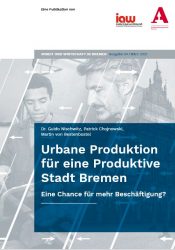 In a research project of the iaw, the conceptual foundations of urban production and the productive city were prepared with a view to the situation in Bremen and analysed in their impact structure. The study makes proposals for describing and recording urban production that is compatible with the city and embedding it in an urban development policy model of a productive city. On the basis of seven reference cities (Vienna, Zurich, Stuttgart, Hamburg, Frankfurt am Main, Wuppertal, Bochum), corresponding activities were filtered out and their transferability to the city of Bremen was examined. In the city of Bremen, eight locations and neighbourhoods (including the Tabakquartier and Kellogg-Areal) were examined with regard to their potential for implementing a productive city.
In a research project of the iaw, the conceptual foundations of urban production and the productive city were prepared with a view to the situation in Bremen and analysed in their impact structure. The study makes proposals for describing and recording urban production that is compatible with the city and embedding it in an urban development policy model of a productive city. On the basis of seven reference cities (Vienna, Zurich, Stuttgart, Hamburg, Frankfurt am Main, Wuppertal, Bochum), corresponding activities were filtered out and their transferability to the city of Bremen was examined. In the city of Bremen, eight locations and neighbourhoods (including the Tabakquartier and Kellogg-Areal) were examined with regard to their potential for implementing a productive city.
 "The raw material wood is precious. It is therefore important to use it responsibly and in a way that conserves resources," warns Peter Aicher, Chairman of Holzbau Deutschland. Even if wood is affected by environmental influences or the bark beetle, it does not represent an inferior raw material, but has almost identical properties to conventional construction timber. "If the so-called 'calamity wood' has the same structural quality in terms of load-bearing capacity as conventional sawn timber, it can be used without restrictions," explains Aicher. In addition, the wood retains its important function as a CO2 sink, regardless of external impairments.
"The raw material wood is precious. It is therefore important to use it responsibly and in a way that conserves resources," warns Peter Aicher, Chairman of Holzbau Deutschland. Even if wood is affected by environmental influences or the bark beetle, it does not represent an inferior raw material, but has almost identical properties to conventional construction timber. "If the so-called 'calamity wood' has the same structural quality in terms of load-bearing capacity as conventional sawn timber, it can be used without restrictions," explains Aicher. In addition, the wood retains its important function as a CO2 sink, regardless of external impairments.
A new study from Denmark takes a look at the costs of sustainable building construction and shows that more sustainable does not automatically mean more expensive. On the contrary. The study by Buus Consult on behalf of the DGNB system partner from Denmark, the Green Building Council Denmark, now provides clarity. In the study, it takes a close look at 37 DGNB-certified buildings.
 With the portal https://energiewendedörfer.de the University of Kassel and Georg-August-Universität Göttingen will present the initial results from the joint project "Innovative concepts and business models for sustainable bioenergy villages - climate-friendly, democratic, citizen-centred". In particular, concepts are being developed for bioenergy and biogas plants that can enable continued economic operation after the current 20-year EEG phase.
With the portal https://energiewendedörfer.de the University of Kassel and Georg-August-Universität Göttingen will present the initial results from the joint project "Innovative concepts and business models for sustainable bioenergy villages - climate-friendly, democratic, citizen-centred". In particular, concepts are being developed for bioenergy and biogas plants that can enable continued economic operation after the current 20-year EEG phase.
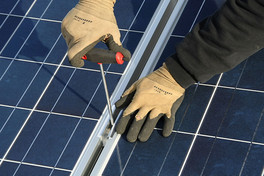 "To be climate neutral by 2050, we not only need to make additional investments in green and innovative technologies of the future. Above all, we also need a shift from existing investments in 'brown' raw materials such as coal, oil and gas to 'green' climate-friendly technologies. The phase-out of fossil fuels must be global and rapid, in line with the goals of the World Climate Conference. Only in this way can we realistically achieve the climate protection goals. Churches, municipalities and also companies are setting new standards here and demonstrating the feasibility of the changeover in both ecological and economic terms," said Environment Minister Ulrike Höfken today at the event "Divestment and Sustainable Finance", which took place during the Climate Protection Weeks in Rhineland-Palatinate.
"To be climate neutral by 2050, we not only need to make additional investments in green and innovative technologies of the future. Above all, we also need a shift from existing investments in 'brown' raw materials such as coal, oil and gas to 'green' climate-friendly technologies. The phase-out of fossil fuels must be global and rapid, in line with the goals of the World Climate Conference. Only in this way can we realistically achieve the climate protection goals. Churches, municipalities and also companies are setting new standards here and demonstrating the feasibility of the changeover in both ecological and economic terms," said Environment Minister Ulrike Höfken today at the event "Divestment and Sustainable Finance", which took place during the Climate Protection Weeks in Rhineland-Palatinate.
 With the gradual dismantling of ten particularly climate-damaging subsidies in the energy, transport and agricultural sectors, Germany could generate up to 46 billion euros in revenue annually. This is the result of a new study by the "Forum Ökologisch-Soziale Marktwirtschaft" commissioned by Greenpeace.
With the gradual dismantling of ten particularly climate-damaging subsidies in the energy, transport and agricultural sectors, Germany could generate up to 46 billion euros in revenue annually. This is the result of a new study by the "Forum Ökologisch-Soziale Marktwirtschaft" commissioned by Greenpeace.
 "In key policy areas, it is not enough to take additional steps; instead, a fundamental transformation must be initiated - the Federal Government recognises this with its dialogue version of the German Sustainability Strategy. The momentum for this transformation is now, and it needs tailwind from all ministries," explained Dr. Werner SchnappaufChairman of the German Council for Sustainable Development (RNE). "The version of the dialogue brings important innovations that will allow the policies of the coming years to be more closely aligned with the guiding principle of sustainability. The designation of transformation areas such as the energy and transport transition or the transition to a circular economy is an important step forward. At the same time, we believe that there is still room for improvement in some areas," said Schnappauf.
"In key policy areas, it is not enough to take additional steps; instead, a fundamental transformation must be initiated - the Federal Government recognises this with its dialogue version of the German Sustainability Strategy. The momentum for this transformation is now, and it needs tailwind from all ministries," explained Dr. Werner SchnappaufChairman of the German Council for Sustainable Development (RNE). "The version of the dialogue brings important innovations that will allow the policies of the coming years to be more closely aligned with the guiding principle of sustainability. The designation of transformation areas such as the energy and transport transition or the transition to a circular economy is an important step forward. At the same time, we believe that there is still room for improvement in some areas," said Schnappauf.
 Glaciers are melting, sea levels are rising, heat waves and heavy rainfall are increasing: The consequences of climate change are visible and tangible worldwide, and the window of opportunity to act is shrinking. In order to significantly limit the global effects of climate change, the emission of greenhouse gases on earth must be drastically reduced. The agreement reached by the international community in Paris in 2015 sets the goal of limiting global warming to well below 2 degrees Celsius, but preferably to 1.5 degrees Celsius. Now, the Wuppertal Institute presented a study with possible cornerstones that can help to achieve the 1.5 degree target by 2035. The study shows that a climate-neutral energy system by 2035 is very ambitious, but in principle feasible, provided that all possible strategies from today's perspective are bundled. This requires, above all, bringing forward and intensifying measures that are described in many studies as necessary to achieve greenhouse gas neutrality by 2050.
Glaciers are melting, sea levels are rising, heat waves and heavy rainfall are increasing: The consequences of climate change are visible and tangible worldwide, and the window of opportunity to act is shrinking. In order to significantly limit the global effects of climate change, the emission of greenhouse gases on earth must be drastically reduced. The agreement reached by the international community in Paris in 2015 sets the goal of limiting global warming to well below 2 degrees Celsius, but preferably to 1.5 degrees Celsius. Now, the Wuppertal Institute presented a study with possible cornerstones that can help to achieve the 1.5 degree target by 2035. The study shows that a climate-neutral energy system by 2035 is very ambitious, but in principle feasible, provided that all possible strategies from today's perspective are bundled. This requires, above all, bringing forward and intensifying measures that are described in many studies as necessary to achieve greenhouse gas neutrality by 2050.
 Hydrogen is an important alternative for sectors stuck in the fossil fuel economy. As national governments and European parliamentarians negotiate the EU's hydrogen strategy, EASAC issues a new commentary. "Hydrogen can help reduce our dependence on fossil fuels," says William Gillett, Director of EASAC's Energy Programme. "But the climate benefits are limited if we use fossil fuels to produce it - even with carbon capture and storage. The EU must put an end to fossil fuel subsidies. The rapidly growing demand for hydrogen must be met by a massive increase in electricity generation from renewables, together with certified imports from third countries."
Hydrogen is an important alternative for sectors stuck in the fossil fuel economy. As national governments and European parliamentarians negotiate the EU's hydrogen strategy, EASAC issues a new commentary. "Hydrogen can help reduce our dependence on fossil fuels," says William Gillett, Director of EASAC's Energy Programme. "But the climate benefits are limited if we use fossil fuels to produce it - even with carbon capture and storage. The EU must put an end to fossil fuel subsidies. The rapidly growing demand for hydrogen must be met by a massive increase in electricity generation from renewables, together with certified imports from third countries."
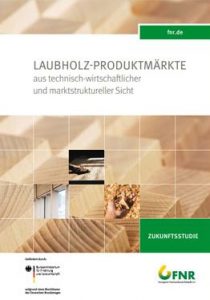 A study funded by the Federal Ministry of Agriculture determined the potential of hardwood as a substitute for coniferous wood. The results of the study are now available in a brochure published by the Fachagentur Nachwachsende Rohstoffe e. V. (FNR). There is considerable potential for hardwood to be used in industrial timber, but it cannot yet be a substitute for softwood in construction
A study funded by the Federal Ministry of Agriculture determined the potential of hardwood as a substitute for coniferous wood. The results of the study are now available in a brochure published by the Fachagentur Nachwachsende Rohstoffe e. V. (FNR). There is considerable potential for hardwood to be used in industrial timber, but it cannot yet be a substitute for softwood in construction
CO2-Emissions should be reduced by 65 percent over the next ten years compared to 1990 in order to achieve climate neutrality - Energy system must be converted to 100 percent renewable energies by 2040 - Investment of 3,000 billion euros required to meet European Green Deal and Paris climate targets - German EU Council Presidency can ensure that Corona aid packages link economic stimulus with climate protection
 30.06.2020 - 16 players in the German financial sector, with assets of more than €5.5 trillion and over 46 million customer connections in Germany, have signed a voluntary commitment to align their loan and investment portfolios in line with the goals of the Paris Climate Agreement. Through the agreed measurement, publication and target setting to reduce the emissions associated with the loan and investment portfolios, the financial sector intends to make a contribution to climate protection and support the sustainable and future-oriented further development of the economy. This brings the German financial centre one step closer to the goal set by the German government at the beginning of 2019 of making Germany one of the leading locations for sustainable finance.
30.06.2020 - 16 players in the German financial sector, with assets of more than €5.5 trillion and over 46 million customer connections in Germany, have signed a voluntary commitment to align their loan and investment portfolios in line with the goals of the Paris Climate Agreement. Through the agreed measurement, publication and target setting to reduce the emissions associated with the loan and investment portfolios, the financial sector intends to make a contribution to climate protection and support the sustainable and future-oriented further development of the economy. This brings the German financial centre one step closer to the goal set by the German government at the beginning of 2019 of making Germany one of the leading locations for sustainable finance.
 At the proposal of the Federal Environment Ministry, the Federal Cabinet adopted the third German Resource Efficiency Programme (ProgRess III) on 17 June 2020. With this programme, the government aims to achieve an economical use of raw materials. Companies in particular are to use natural resources more efficiently along the entire value chain. Greater use is to be made of digital solutions to increase resource efficiency. The decision in favour of resource-saving products is to be made easier for citizens through improved information.
At the proposal of the Federal Environment Ministry, the Federal Cabinet adopted the third German Resource Efficiency Programme (ProgRess III) on 17 June 2020. With this programme, the government aims to achieve an economical use of raw materials. Companies in particular are to use natural resources more efficiently along the entire value chain. Greater use is to be made of digital solutions to increase resource efficiency. The decision in favour of resource-saving products is to be made easier for citizens through improved information.
 Brussels/Freiburg, 5 May 2020 - An alliance "Solar Europe Now", officially launched on 5 May, is calling for solar energy to be recognised as a key technology for the objectives of the European Green Deal. The new alliance, which currently includes more than 90 players from the entire value chain of the European solar industry, is concerned that the photovoltaic sector is not being given enough consideration in the current presentation of the Green Deal.
Brussels/Freiburg, 5 May 2020 - An alliance "Solar Europe Now", officially launched on 5 May, is calling for solar energy to be recognised as a key technology for the objectives of the European Green Deal. The new alliance, which currently includes more than 90 players from the entire value chain of the European solar industry, is concerned that the photovoltaic sector is not being given enough consideration in the current presentation of the Green Deal.
 Eine Studie des Forums Ökologisch-Soziale Marktwirtschaft im Auftrag von Greenpeace (März 2020).
Durch die Corona-Krise wird der Staat Soforthilfen und weitreichende Konjunkturmaßnahmen historischen Ausmaßes umsetzen. Während Gesundheit und die kurzfristige Unterstützung von Arbeitnehmer*innen und Unternehmen in den Fokus rücken, dürfen die Fehler vergangener Wirtschaftskrisen nicht wiederholt werden. Die geplanten Hilfen für einen wirtschaftlichen Neustart können die Weichen stellen für die notwendige Transformation. Anhand einiger Beispiele wird illustriert, wie kurzfristige wirtschaftliche Unterstützung mit langfristigen gesellschaftlichen Prioritäten in Einklang gebracht werden können.
Eine Studie des Forums Ökologisch-Soziale Marktwirtschaft im Auftrag von Greenpeace (März 2020).
Durch die Corona-Krise wird der Staat Soforthilfen und weitreichende Konjunkturmaßnahmen historischen Ausmaßes umsetzen. Während Gesundheit und die kurzfristige Unterstützung von Arbeitnehmer*innen und Unternehmen in den Fokus rücken, dürfen die Fehler vergangener Wirtschaftskrisen nicht wiederholt werden. Die geplanten Hilfen für einen wirtschaftlichen Neustart können die Weichen stellen für die notwendige Transformation. Anhand einiger Beispiele wird illustriert, wie kurzfristige wirtschaftliche Unterstützung mit langfristigen gesellschaftlichen Prioritäten in Einklang gebracht werden können.
While the emergency aid for companies is getting underway, the debate about possible post-crisis economic stimulus packages is also gaining momentum. The German Green Business Association is proposing a transformation fund to combine a new start for the economy with social aspects and environmental and climate protection.
- Over EUR 28 billion for "climate protection measures": KfW is one of the most important supporters of the Paris climate goals
- Promotional bank is a global pioneer with its standardised SDG mapping
- Strong international interest in KfW SDG mapping
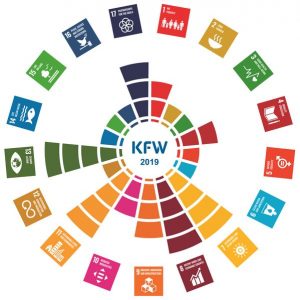 KfW is today publishing the results of the SDG mapping of new commitments throughout the Group in 2019. In order to clarify the individual contribution made by KfW's new commitments to achieving the UN Sustainable Development Goals, KfW has developed a standardised procedure: 1,500 indicators are used each year to determine to which SDGs KfW's new commitments can be assigned. This makes the contribution transparent at both group and business sector level.
KfW is today publishing the results of the SDG mapping of new commitments throughout the Group in 2019. In order to clarify the individual contribution made by KfW's new commitments to achieving the UN Sustainable Development Goals, KfW has developed a standardised procedure: 1,500 indicators are used each year to determine to which SDGs KfW's new commitments can be assigned. This makes the contribution transparent at both group and business sector level.From 2022, all new public buildings must be made of at least 50 per cent wood or other sustainable building materials. For buildings with more than eight storeys, the supporting structure must even be made entirely of wood. It was also decided that 90 ecological neighbourhoods and 100 urban farms will be built in Paris.
Since 1 January 2020, all new buildings and general renovations of the BIG Group have been subject to the Group-wide mandatory minimum sustainable standard. The BIG minimum standard goes beyond the legal requirements and ensures that all projects of BIG and its subsidiary ARE achieve the klimaaktiv SILVER standard in any case. The sustainable minimum standard of the Bundesimmobiliengesellschaft (BIG) is a catalogue of criteria that must already be taken into account in the planning process for buildings. This makes the implementation of 43 measures of the BIG Holistic Building Programme (HBP)* and the achievement of at least 750 klimaaktiv points mandatory for all new construction and general refurbishment projects for which a planning invention procedure will be carried out from 2020. By implementing the minimum standard, CO2 emission values are significantly reduced, climate-damaging building materials are avoided and the phase-out of fossil fuels is accelerated.
 Recently, the Austrian state of Vorarlberg published the subsidy guidelines for 2020 and 2021 for residential renovation and new construction in the private and public sectors. The climate-friendly procurement of wood and wood products from the region is anchored in these guidelines. The origin of the wood must be proven by means of the "Holz von Hier" label recently introduced in Austria or comparable certificates.
Recently, the Austrian state of Vorarlberg published the subsidy guidelines for 2020 and 2021 for residential renovation and new construction in the private and public sectors. The climate-friendly procurement of wood and wood products from the region is anchored in these guidelines. The origin of the wood must be proven by means of the "Holz von Hier" label recently introduced in Austria or comparable certificates.
A research project conducted by natureplus in conjunction with IFEU compares insulation materials with regard to their environmental impact throughout their entire life cycle, including recovery and recycling.

 Which insulation material is the best? This question is extremely popular in the construction industry and can ultimately only be answered in the context of the respective construction. In particular, there has so far been a lack of a holistic overview that enables builders and planners to identify the strengths and weaknesses of the various insulation material alternatives in terms of their life cycle assessment, without having to disregard subsequent disposal.
Which insulation material is the best? This question is extremely popular in the construction industry and can ultimately only be answered in the context of the respective construction. In particular, there has so far been a lack of a holistic overview that enables builders and planners to identify the strengths and weaknesses of the various insulation material alternatives in terms of their life cycle assessment, without having to disregard subsequent disposal.
Thuringia is making six million euros available this year for investments in municipal climate protection. The funding comes from the state's "Klima Invest" programme, which has already provided more than 15.5 million euros in investments in municipalities since the beginning of 2018, as the Ministry of the Environment announced in Erfurt on Thursday. 312 applications for funding have been approved.
 27.01.2020 A material revolution that replaces cement and steel with wood in urban construction can have double benefits for climate stabilization. This is now shown in a study by an international team of scientists. First, it can avoid greenhouse gas emissions from cement and steel production. Secondly, it can turn buildings into carbon sinks, since in the construction timber the CO2 is stored. Although the required amount of wood is theoretically available, such an expansion would require very careful sustainable forest management, the authors emphasize.
27.01.2020 A material revolution that replaces cement and steel with wood in urban construction can have double benefits for climate stabilization. This is now shown in a study by an international team of scientists. First, it can avoid greenhouse gas emissions from cement and steel production. Secondly, it can turn buildings into carbon sinks, since in the construction timber the CO2 is stored. Although the required amount of wood is theoretically available, such an expansion would require very careful sustainable forest management, the authors emphasize.
 The share of renewable energies in electricity consumption rises to almost 43 percent. The climate protection successes in the electricity sector are diminished by rising greenhouse gas emissions in buildings and transport. In parallel, public interest in climate protection is rising: since May 2019, it has consistently been the most pressing political issue in the eyes of the population. This is shown by Agora Energiewende's 2019 annual evaluation.
The share of renewable energies in electricity consumption rises to almost 43 percent. The climate protection successes in the electricity sector are diminished by rising greenhouse gas emissions in buildings and transport. In parallel, public interest in climate protection is rising: since May 2019, it has consistently been the most pressing political issue in the eyes of the population. This is shown by Agora Energiewende's 2019 annual evaluation.
 ROBIN WOOD has scrutinized the green electricity offers of 1,200 providers and publishes the results today in the "ROBIN WOOD Eco-Electricity Report 2020.". The environmental organization rates eight offers as recommendable. The current research report was realized with the support of the Open Knowledge Foundation Germany.
ROBIN WOOD has scrutinized the green electricity offers of 1,200 providers and publishes the results today in the "ROBIN WOOD Eco-Electricity Report 2020.". The environmental organization rates eight offers as recommendable. The current research report was realized with the support of the Open Knowledge Foundation Germany.
 The aim of the handbook is to provide municipal actors with concrete tools that can be used to keep and locate production in urban areas. In the joint project UrbaneProduktion.Ruhr, funded by the Federal Ministry of Education and Research, research was carried out from October 2016 to December 2019 into whether and how it is possible to bring production back to the city.
The aim of the handbook is to provide municipal actors with concrete tools that can be used to keep and locate production in urban areas. In the joint project UrbaneProduktion.Ruhr, funded by the Federal Ministry of Education and Research, research was carried out from October 2016 to December 2019 into whether and how it is possible to bring production back to the city.
For almost fifteen years, Rob Hopkins has been developing a method for preparing our societies for the coming upheavals. Video: 5 min, available from 6.12.2019 to 8.12.2021
 While European environmental and climate policies have helped to improve the state of the environment in recent decades, progress has been insufficient and the outlook for the environment over the next decade is bleak, according to the report "The Environment in Europe - State and Outlook 2020en (SOER 2020)" is not positive.
The SOER 2020 is the most comprehensive environmental assessment ever undertaken for Europe. It provides an unsparing snapshot of Europe's position in terms of achieving its 2020 and 2030 policy targets, as well as its longer-term 2050 goals and ambitions for a transition to a sustainable, low-carbon future. The report points out that Europe has already made significant progress in mitigating climate change by reducing greenhouse gas emissions over the past two decades. There are also signs of progress in other areas. Examples include the fight against air and water pollution, new strategies against plastic waste, progress in adapting to climate change and in the areas of circular economy and bioeconomy. In addition, the EU Sustainable Finance Initiative addresses for the first time the role of the financial sector in the necessary transition towards a sustainable future.
While European environmental and climate policies have helped to improve the state of the environment in recent decades, progress has been insufficient and the outlook for the environment over the next decade is bleak, according to the report "The Environment in Europe - State and Outlook 2020en (SOER 2020)" is not positive.
The SOER 2020 is the most comprehensive environmental assessment ever undertaken for Europe. It provides an unsparing snapshot of Europe's position in terms of achieving its 2020 and 2030 policy targets, as well as its longer-term 2050 goals and ambitions for a transition to a sustainable, low-carbon future. The report points out that Europe has already made significant progress in mitigating climate change by reducing greenhouse gas emissions over the past two decades. There are also signs of progress in other areas. Examples include the fight against air and water pollution, new strategies against plastic waste, progress in adapting to climate change and in the areas of circular economy and bioeconomy. In addition, the EU Sustainable Finance Initiative addresses for the first time the role of the financial sector in the necessary transition towards a sustainable future.
 Grenzach-Wyhlen, December 5, 2019. Hydrogen production in Grenzach-Wyhlen in Baden-Württemberg can start. Energiedienst received approval for the operation of the power-to-gas plant today. All technical proofs and official clarifications have now been fulfilled.
Energiedienst will produce hydrogen from self-generated green electricity using electrolysis in the state-of-the-art plant. The electricity comes from the company's own hydroelectric power plant on the same site. The environmentally friendly hydrogen will initially be used in nearby industry. There are also plans to use it in local public transport. A comprehensive concept also envisages that the waste heat generated during electrolysis will be used to heat a new residential area. By linking electricity, mobility and heat supply in this way - keyword: sector coupling - the plant should help to reduce CO2 emissions and support the energy transition.
Grenzach-Wyhlen, December 5, 2019. Hydrogen production in Grenzach-Wyhlen in Baden-Württemberg can start. Energiedienst received approval for the operation of the power-to-gas plant today. All technical proofs and official clarifications have now been fulfilled.
Energiedienst will produce hydrogen from self-generated green electricity using electrolysis in the state-of-the-art plant. The electricity comes from the company's own hydroelectric power plant on the same site. The environmentally friendly hydrogen will initially be used in nearby industry. There are also plans to use it in local public transport. A comprehensive concept also envisages that the waste heat generated during electrolysis will be used to heat a new residential area. By linking electricity, mobility and heat supply in this way - keyword: sector coupling - the plant should help to reduce CO2 emissions and support the energy transition.




